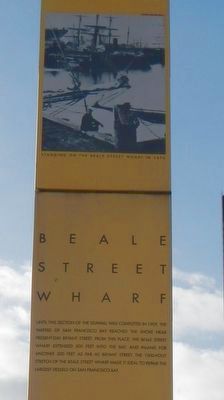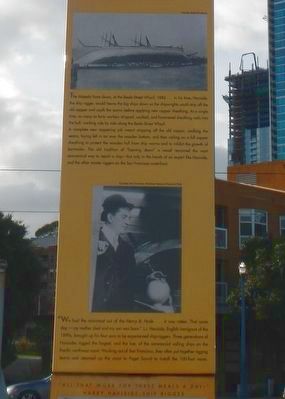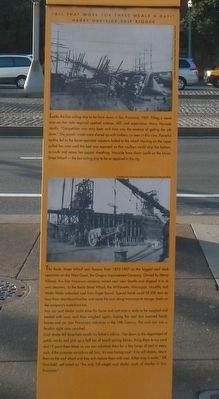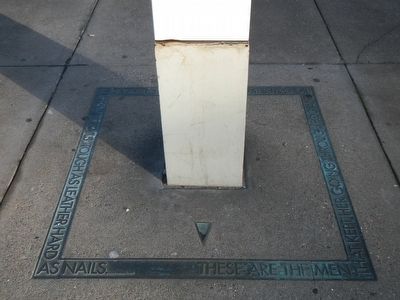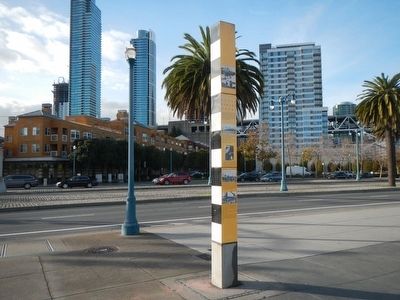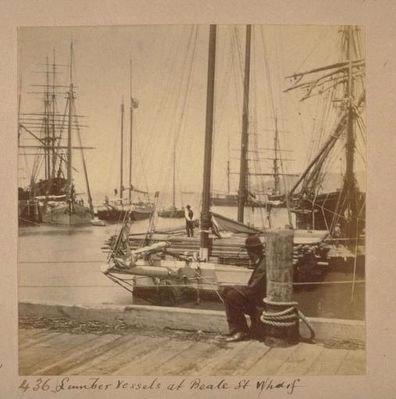South Beach in San Francisco City and County, California — The American West (Pacific Coastal)
Beale Street Wharf
Inscription.
Until this section of the seawall was completed in 1909, the waters of San Francisco Bay reached the shore near present-day Bryant Street. From this place, the Beale Street Wharf extended 500 feet into the bay, and inland for another 500 feet as far as Bryant Street. The 1000-foot stretch of Beale Street Wharf made it ideal to repair the largest vessels on San Francisco Bay.
(photograph 2)
The Majestic hove down, at the Beale Street Wharf, 1886... In his time, Haviside, the ship rigger, would heave the big ships down so the shipwrights could strip of the old copper and caulk the seams before applying new copper sheathing. At a single time, as many as forty workers stripped, caulked, and hampered sheathing nails into the hulk, working side by side along the Beale Street Wharf.
A complete new coppering job meant stripping off the old copper, caulking the seams, laying felt in tar over the wooden bottom, and then nailing on a full copper sheathing to protect the wooden hull from ship worms and to inhibit the growth of barnacles. The old tradition of "heaving down" a vessel remained the most economical way to repair a ship - but only in the hands of an expert like Haviside and the other master riggers on the San Francisco waterfront.
(photograph 3)
"We had the mainmast out of the Henry B. Hyde... it was rotten. That same day - my mother died and my son was born." J.J. Haviside, English immigrant of the 1890s, brought up his four sons to be experienced ship-riggers. Three generations of Havisides rigged the largest, and the last, of the commercial sailing ships on the Pacific northwest coast. Working out of San Francisco, they often put together rigging teams and steamed up the coast to Puget Sound to install the 100-foot masts.
(Photograph 4)
Lucile, the last sailing ship to be hove down in San Francisco, 1901. Tilting a vessel over on her side required applied science, skills and experience. Harry Haviside recalls, "Competition was very keen and time was the essence of getting the job done." The vessels' masts were shored up with timbers, as seen in this view. Powerful tackles lead to the horse-operated capstans bolted to the wharf. Hauling on the ropes pulled her over until the keel was exposed so that the caulkers could strip the bottom, re-caulk and renew her copper sheathing. Haviside hove down Lucile on the Union Street Wharf - the last sailing ship to be so repaired in the city.
(photograph 5)
The Beale Street Wharf was famous from 1872-1907 as the biggest coal dock
operation on the West Coast, the Oregon Improvement Company. Owned by Henry Villiard, this San Francisco company mined coal near Seattle and shipped it in its own steamers. At the Beale Street Wharf, the Williamette, Mississippi, Umatilla, and Walla Walla unloaded coal from Puget Sound. Special hoists could lift 200 tones an hours from steamboat hatches and move the coal along tramways to storage sheds on the company's waterfront lots.
Any city coal dealer could drive his horse and cart onto a scale to be weighed and loaded with coal, and then weighed again, buying the coal that warmed family homes and ran San Francisco industries in the 19th Century. The coal cart was a familiar sight now vanished.
Coal dealer Bill Granfield recalls his father's advice: "Go down to the department of public works and pick up a half ton of basalt paving blocks. Bring them to my yard and I'll paint them black so you can substitute them for a few lumps of coal in every sack. If the customer complains tell him, 'It's ever-lasting coal.' If he still objects, return them to the coal wharf and they will replace them with coal. Either way its works." Bill Granfield, self-styled as "the only full-weight coal dealer south of Market in San Francisco."
Erected by San Francisco Art Commission for the Waterfront Transportation Projects
.
Topics. This historical marker is listed in these topic lists: Industry & Commerce • Waterways & Vessels.
Location. 37° 47.098′ N, 122° 23.265′ W. Marker is in San Francisco, California, in San Francisco City and County. It is in South Beach. Marker is on The Embarcadero near Brannan Street, on the right when traveling north. Touch for map. Marker is at or near this postal address: 625 The Embarcadero, San Francisco CA 94105, United States of America. Touch for directions.
Other nearby markers. At least 8 other markers are within walking distance of this marker. Beale Street (within shouting distance of this marker); Brannan Street (within shouting distance of this marker); The Bay Bridge (within shouting distance of this marker); Fremont Street (about 500 feet away, measured in a direct line); The Matson Line (about 600 feet away); The Alaska Packers (about 600 feet away); Bryant Street (about 700 feet away); Building the Seawall (about 800 feet away). Touch for a list and map of all markers in San Francisco.
More about this marker. The black and white tiles on the other three side side of the pylon list the name and professions of "19th century craftsmen in the maritime trades who worked along the San Francisco waterfront... They turned timbers into spars, caulked the seams of wooden vessels and coppered
bottoms. They set the masts and rigged the sails, shaped and carved timbers with tools of their trade learned in the ports of the world. They brought with them the folkways of different races and many countries, and in so doing added much to San Francisco culture."
Credits. This page was last revised on February 7, 2023. It was originally submitted on March 8, 2016, by Barry Swackhamer of Brentwood, California. This page has been viewed 599 times since then and 44 times this year. Photos: 1, 2, 3, 4, 5, 6. submitted on March 8, 2016, by Barry Swackhamer of Brentwood, California.
